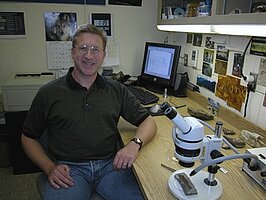Evolution of Fish Growth and its Response to Climate

Michael Newbrey's general research interests include freshwater teleost systematics, biogeography, and ecology for both extant and extinct fish. In the past, his research focus has been on the osteoglossids and esocids, but is now including other taxa in the dissertation research. He has a Bachelor's degree in Biology with Fisheries and Limnology emphasis (1998) and a Masters degree in Natural Resources (2002) both from the University of Wisconsin at Stevens Point. For his M.S. degree, he studied the morphology of submerged trees and fish cribs as fish habitat in Katherine Lake of northern Wisconsin.
Email: michael.newbrey@ndsu.edu
Fellow: Michael Newbrey, Department of Biological Sciences, NDSU
Advisor: Allan Ashworth, Professor of Geology, Department of Geosciences, NDSU
Matching Support: NDSU
Degree Progress: Ph.D. expected in December 2006.
Evolution of Fish Growth and its Response to Climate
Very little is known about growth and the life history characteristics of fish in the fossil record. Fossils can provide valuable information about growth of extinct forms of fish, thereby providing insight into their life histories and ecology.
Project objectives:
My project entails an examination of the relationships between age, growth, longevity, and climate on a geologic scale. The objectives of this study are to: 1). examine the age and growth patterns of fossil freshwater hiodontids, esocids, and the percid, Perca flavescens from all fossil localities known to produce these taxa in North America; and 2). quantify patterns of growth of extant hiodontids, esocids, and the percid, Perca flavescens from a range of latitudes and ambient mean annual temperatures (MAT) to understand the effects of MAT on fish growth; 3) contrast the growth patterns from fossil fish to that of extant populations to examine evolutionary patterns.
Progress:
In previous research, I have contrasted growth of living forms of pike (Esox) to that of fossils. More recently, I have been working with yellow perch (Perca flavescens). The research has shown that growth of living and extinct closely related species are similar. By examining the growth patterns of contemporary pike and yellow perch across their ranges, I have found that mean annual air temperature describes variation in growth. Furthermore, changes in age and growth of Esociformes and Hiodontiformes since the Cretaceous show trends in time that are correlated with climate change.
Pleistocene fossils can also be used to examine the effects of climate change on fish. Allan Ashworth and I reexamined a well-preserved late Pleistocene to early Holocene fossil fish assemblage from lake deposits on the Missouri Coteau, near Buchanan, North Dakota. Our findings were published in the Canadian Journal of Fisheries and Aquatic Sciences. We reported that fossil fish abundance, stratigraphy, pollen, and charcoal provided information about postglacial colonization and the subsequent population fluctuations during a time of climatic warming. The fossil fish included complete specimens of Perca flavescens, Hybognathus hankinsoni, Notropis heterolepis, Fundulus diaphanous, and Culaea inconstans. The sequence of colonization for each species was correlated with individual thermal and relative water velocity tolerances. We found that fish abundance fluctuates six times during an approximate 1000 year depositional history. Charcoal abundance, representing fires, was inferred to represent episodic droughts during which nutrient levels were reduced and fish abundance declined. The fluctuations followed an overall trend to increased abundance during a time when the lake-margin vegetation changed from a spruce to a deciduous forest in response to climatic warming. The research provides insight into the effects of a changing climate on fish populations and demonstrates the potential of using fossils to examine long-term processes regarding contemporary fish species.
Significance:
Ultimately, this research will document the changes in evolution of growth of extinct species during climate change and help to understand how contemporary species respond to climate change.
Related Publications and Presentations:
Publications:
Newbrey, M.G. and M.V.H. Wilson. 2005. Recognition of annular growth on centra of Teleostei with application to Hiodontidae of the Cretaceous Dinosaur Park Formation. Dinosaur Park Symposium, Royal Tyrrell Museum, Drumheller, Alberta.
Newbrey, M.G., M.V.H. Wilson, and A.C. Ashworth. 2005. Growth characteristics of Cretaceous and Cenozoic North American Esociformes: Implications for systematics. In Fourth International Meeting on Mesozoic Fishes - Systematics, Homology, and Nomenclature, Extended Abstracts; edited by F.J. Poyato-Ariza; Madrid, Servicio de Publicaciones de la Universidad Autónoma de Madrid / UAM Ediciones. pp. 201-204.
Newbrey, M.G. and A.C. Ashworth. 2004. A fossil record of colonization and response of lacustrine fish populations to climate change. Canadian Journal of Fisheries and Aquatic Sciences 61(10):1807-1816.
Presentations:
Newbrey, M.G., M.V.H. Wilson, and A.C. Ashworth. Growth characteristics of North American Hiodontidae (Teleostei) from the Late Cretaceous to Recent. Society of Vertebrate Paleontology 65 th Annual Meeting. Journal of Vertebrate Paleontology 25(supplement to 3). To be presented in Phoenix, AZ, October 19-22, 2005.
Newbrey, M.G., M.V.H. Wilson, and A.C. Ashworth. 2005. Growth characteristics of Cretaceous and Cenozoic North American Esociformes: Implications for systematics. Fourth International Meeting on Mesozoic Fishes, Miraflores de la Sierra, Madrid, Spain, August 8-13.
Newbrey, M.G. and A.C. Ashworth. 2005. If fossil fish could talk we would hear stories about drought: An examination of a late Pleistocene deposit near Jamestown, North Dakota. North Dakota Geological Society, Bismarck, North Dakota. May 17th.
Newbrey, M.G., A.C. Ashworth, and M.V.H. Wilson. 2005. Geographic trends in North American Freshwater Fishes from the Cretaceous to the Pliocene: A climatic effect? Northern Plains Biological Symposium, Fargo, North Dakota.
Newbrey, M.G., A.C. Ashworth, and M.V.H. Wilson. 2004. Geographic trends in North American Freshwater Fishes from the Cretaceous to the Pliocene. Society of Vertebrate Paleontology 64 th Annual Meeting. Journal of Vertebrate Paleontology 24(supplement to 3):98A.
Newbrey, M.G. and A.C. Ashworth. 2003. Fish community dynamics, growth of yellow perch, and correlations with climate and fire in an early Holocene lake in North Dakota. Society of Vertebrate Paleontology 63 rd Annual Meeting. Journal of Vertebrate Paleontology 23(supplement to 3):82A-83A.
Posters:
Newbrey, M.G. and M.V.H. Wilson. 2005. Recognition of annular growth on centra of Teleostei with application to Hiodontidae of the Cretaceous Dinosaur Park Formation. Dinosaur Park Symposium, Royal Tyrrell Museum, Drumheller, Alberta.
Newbrey, M.G. and J.L. Newbrey. 2004. Evidence for long-term abundance fluctuations of piscivorous birds in North Dakota from a fossil record of fish populations responding to climate change. North Dakota Chapter of the Wildlife Society Annual Meeting.
Newbrey, M.G. and A.C. Ashworth. July 2003. A new method to estimate early Holocene mean annual temperature using growth characteristics of fossil Perca flavescens (yellow perch). XVI International Union for Quaternary Research Congress.

Allan Ashworth
Geosciences
Telephone: 701-231-7919
Email: allan.ashworth@ndsu.edu


